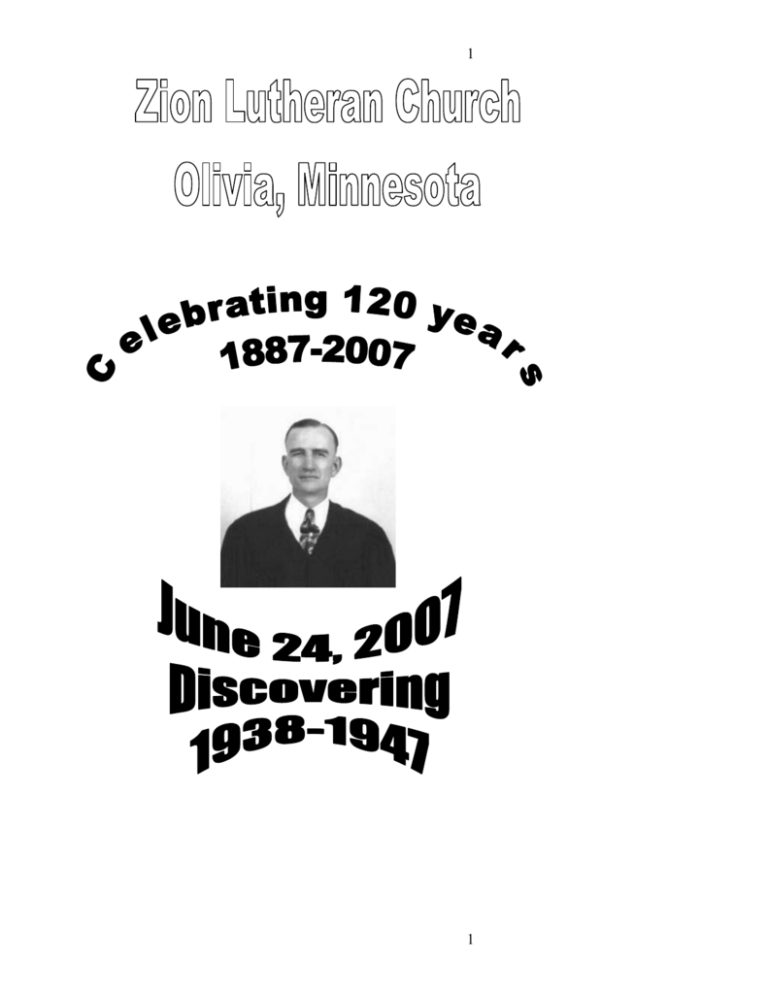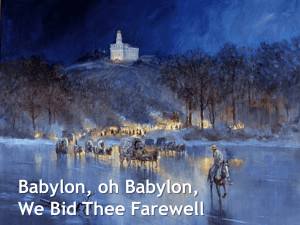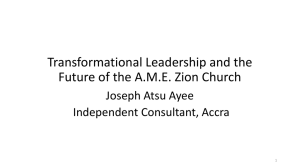1938-1947 - Zion Evangelical Lutheran Church
advertisement

1 1 2 Zion Lutheran Church Olivia, Minnesota 1938-1947 Prepared for distribution on Pentecost 4, June 24, 20071 The Depression in America and World War II tested the United States, as well as the Synod, including the Minnesota District. These trying times were felt in all areas of living, including religious matters. All church work did not grind to a halt, however. In fact, there were encouraging developments. For the country as a whole, the best record in the ratio of charitable and religious giving to total spending was set during the Great Depression, and still stands.2 Mission work continued, but expansion was curtailed. “Missionaries in the field continued their earnest efforts to bring Christ’s Gospel to immortal souls with unabated zeal.” Classes that began preparatory school in the early thirties and graduated in the late thirties, were among the largest Northwestern School had ever seen. At least 28 ministerial candidates were waiting for assignment each year through the late 30’s. We thank Donna Neubarth for writing this decade’s history booklet. (Golden Jubilee of the Minnesota District of WELS and its Member Congregations 1918-1968) 1 2 2 3 26,000 Synod members were in the armed forces near the end of the War (5,000 from the Minnesota District). LeRoy Baker, a long-time member of Zion recalls his war-time experience: He did not go off to fight in the military. Instead, he was summoned to work at a secret military station in the desert near Hanford, Washington. He was there from 1943 to 1944. His wife Lena and young son were left in Minnesota. His mission was so secret he couldn’t even write to tell Lena about anything he was doing. There he worked with 5,000 to 6,000 people, building barracks and a mess hall. He said the camp and facilities were very nice. He also handled boxes from train cars that traveled right through a long narrow building. He never saw what was in those boxes, but realized later they had something to do with the development of atomic weapons, which helped to end the war. LeRoy did his duty for America. The greater effect of the War was the growing concern for overseas missions, especially in Central America, Europe and Asia, where missions were begun. Pastor Adolf Ackermann (pictured left, photo from Golden Jubilee History book ) served as Minnesota District President from 1936 to 1948. 3 4 Rev. A.W. Blauert served the first years of this decade. His tenure at Zion was from 1927 to 1941. He then received and accepted a call to a mission congregation in Austin, Minnesota. (Zion member Fritzie Brown is Rev. Blauert’s daughter. Rev. Immanuel F. Lenz, (photo right) previously serving Mt. Olive congregation in Graceville, Minnesota since his ordination, was installed on November 30, 1941, by Pastor M.J. Weihausen of Morton, and served throughout this decade and beyond. He preached his first sermon to Zion’s members on Pearl Harbor day – December 7, 1941. Remodeling seems to have been the theme of the ‘40s. The parsonage (pictured) was insulated at a cost of $240. In March of 1941 it was decided to shingle the church 4 5 roof. New floors were installed in the parsonage in 1942. By 1946 the congregation had voted to put a basement under the church, and had collected “quite a sum” for this purpose. Other notables from this decade include: Collection envelope system was adopted to begin in 1938. October 1940 - 150 hymnals were ordered, with Ladies Aid contributing $30 to the cost. Individuals were allowed to purchase hymnals for personal use at a cost of $1 each. August 1941 - Rev. Blauert announced receiving (and later accepting) a call to Austin, Minnesota. September 1941 – Rev. Wehausen of Morton acted as vacancy pastor, receiving $10 per Sunday until Rev. I. Lenz was installed November 30, 1941. November 1941 – Danube congregation decides to call their own pastor. Olivia must do likewise. January 1942 – German services were discontinued. October 1944 – “The discussion to have a memorial service on V-Day reached as follows: In case the Armistice was announced before 3 o’clock p.m.., services would be held that evening at 8:00 o’clock. In the event the announcement is not made public before 5 6 3:00 o’clock p.m., services will be held the evening of the following day at the same time.” (p. 161, Church Record Book (1893-1947) 1945 – The interment of August Segler was the last one at Zion’s Cemetery on the corner of Highway 212 and County Road 14. This cemetery was in operation from 1899 to 1945. Zion’s cemetery is located on County Rd 14 (a.k.a., Elk River Road north of Hwy 212) August 1946 – Discussion led to the church becoming incorporated with the name as Zion Lutheran, Inc. 6 7 January 1947 – Decided to observe the 60 Anniversary th with a special service scheduled for June 15, 1947. A special collection will be channeled to the Building Fund. Former pastors Rev. Birkholz (St. James) and Rev. Albrecht (Glenwood) were asked to speak. A history booklet was to be printed. (See picture previous page.) July 1947 – Inasmuch as the city is launching a program of hard surfacing of streets, a motion carried to petition for hard surfacing of the streets adjacent to the church property. Also to complete the sidewalk, curb, water, and sewer connections. (Church Record Book) In the years 1938 to 1947, there were 83 baptisms, 93 confirmations, 36 marriages, and 34 funerals at Zion congregation. Present members Carol (Laumer) Lippert and Ordell Laumer were among the baptisms, and Shirley (Kunde) Retzlaff and Delbert Wetzel were confirmed during those years. An anniversary is not only for bowing gratefully in the direction and at the feet of those that have gone before; an anniversary is to inspire us to continue and advance the work they began.3 3 (Golden Jubilee of the Minnesota District of WELs and its Member Congregations 1918-1968) 7 8 Zion’s 1941 confirmation Class Pastor A. W. Blauert’s last class at Zion. Shirley (Kunde) Retzlaff is seated – 1st on the left Zion’s 1946 confirmation Class Pastor I. F. Lenz Delbert Wetzel is standing, second from the right in the back row. 8 9 9






